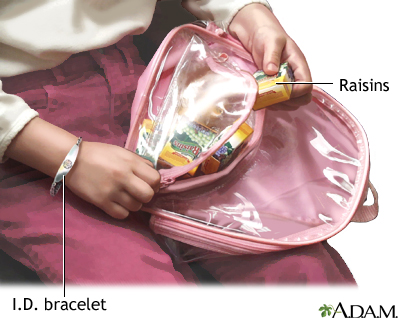| Step 10: Recognize medical emergencies |
When diabetes is poorly controlled, emergency conditions can arise quickly that require immediate treatment.
 |
|
In addition, people with diabetes should always carry a sugar source, such as juice or other sugar-containing beverage, glucose tablets or raisins.

High ketones
When there is not enough insulin to move glucose into cells, glucose can build up in the blood. The body then looks for other forms of energy and uses fat as a fuel source. As fats are broken down, acids called ketones build up in the blood and urine. In high levels, ketones are poisonous to body tissue. This condition is known as ketoacidosis.
You can check for ketones using a simple urine test available at pharmacies. This test should be performed every 4-6 hours anytime a person with diabetes is:
- Registering blood sugar above 240
- Sick, especially with nausea, vomiting, or dehydration
- Unusually thirsty or has a dry mouth
- Urinating frequently

The warning signs that ketoacidosis is getting serious might include:
- Flushed face
- Dry skin and mouth
- Nausea or vomiting
- Stomach pain
- Deep, rapid breathing
- Fruity breath odor
 |
|
Dangerously low blood sugar (Severe hypoglycemia)
Low blood sugar, known as hypoglycemia, can occur in diabetics when they use too much insulin, exercise too hard or too long, or have not eaten enough food. Hypoglycemia can develop quickly in people with diabetes.
Symptoms of low blood sugar typically appear when the sugar level falls below 70. Watch for:
- Weakness
- Shaking
- Sweating
- Headache
- Nervousness
- Hunger
If these symptoms occur and you have a blood sugar test kit available, do a blood sugar check. If the level is low, the person with diabetes should eat something with sugar: fruit juice, several teaspoons of sugar, a cup of skim milk, or regular soda. If you don't have a test kit handy, sugar should be eaten anyway -- it can't hurt. Symptoms should subside within 15 minutes. If the symptoms don't subside, more sugar should be eaten and the sugar level tested again.
AFTER the symptoms subside, more substantial food can be eaten. Eat simple sugar FIRST to get the situation under control. Even if you or your child is hungry, "real" food should not be eaten until the sugar level comes up -- real food won't produce enough sugar and takes too long to digest.
 |
|
Your doctor may want you to have a glucagon kit for emergencies. Consult your doctor about who should learn how to inject glucagon in the event that you or your child has a severe hypoglycemic reaction. Most likely, at least one person at school should be given a glucagon kit and training on how to use it. If you have glucagon stored at home for emergencies, your doctor may want everyone in your home, as well as babysitters and caregivers, to know how to use it. Periodically remind everyone how to use it, and check the expiration date.

Don't panic. Glucagon works very fast -- usually within 15 minutes. While you are waiting for the person to revive, keep him on his side to prevent choking. If the person is not better in 15 minutes, call 911.
 |
|
References
Trachtenberg DS. Diabetic ketoacidosis. Am Fam Physician. 2005;71:1705-1714, 1721-1722.
Alemzadeh R, Wyatt DT. Diabetes mellitus in children. In: Kliegman RM, ed. Kliegman: Nelson Textbook of Pediatrics. 18th ed. Philadelphia, Pa: Saunders;2007:chap 590.
Eisenbarth GS, Polonsky KS, Buse JB. Type 1 diabetes mellitus. In: Kornenberg HM, Melmed S, Polonsky KS, Larsen PR. Kronenberg: Williams Textbook of Endocrinology. 11th ed. Philadelphia, Pa: Saunders Elsevier;2008:chap 31.
Reviewed By: Nancy J. Rennert, MD, FACE, FACP, Chief of Endocrinology & Diabetes, Norwalk Hospital, Associate Clinical Professor of Medicine, Yale School of Medicine, New Haven, CT. Review provided by VeriMed Healthcare Network. Also reviewed by David Zieve, MD, MHA, Medical Director, A.D.A.M., Inc.
